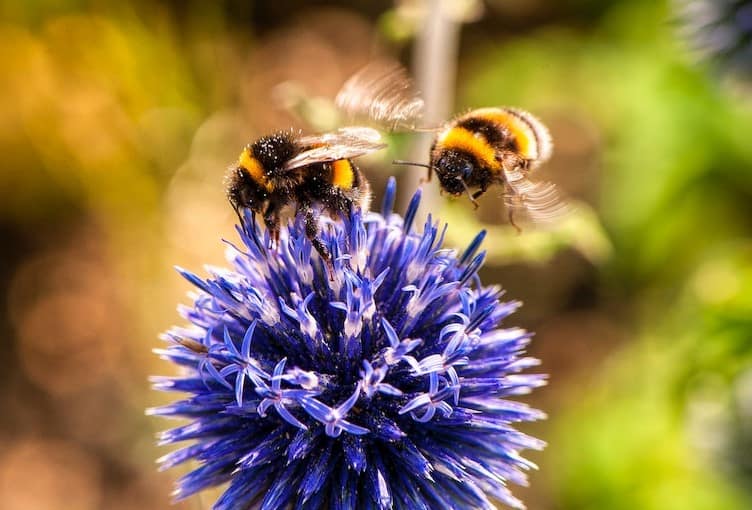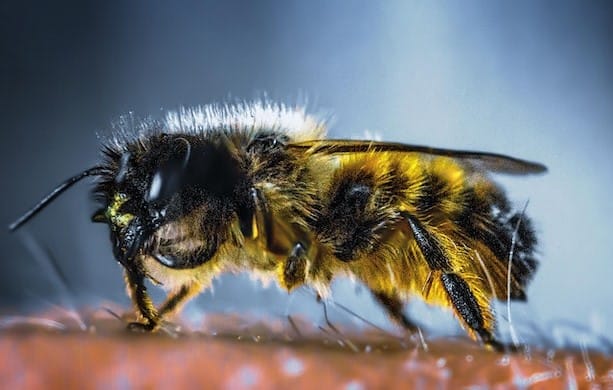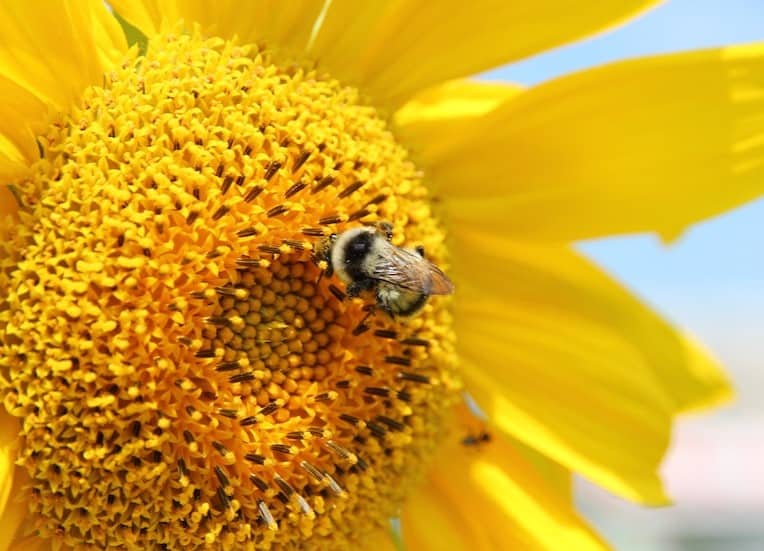Bumblebees are amazing creatures. They are the largest and gentlest of bees – and a true pollination champ! As temperatures warm up, you’ll begin to see some familiar yellow and black insects buzzing around your yard.
Around the world, there are around 20,000 described bee species. Most of these bees are known as solitary bees, with only 250 bumblebee species, 9 honey bee species, and more than 600 social stingless bees worldwide.
Now to the question:
Do Bumble Bees Sting?

Yes, they do, but they do so very rarely. Similar to most bees, bumblebees rarely sting, and they are quite peaceful insects. They will only sting if they feel threatened or their hive is in danger.
They do not form swarms like other bee types and attack. These pollinators only sting when truly provoked.
Only female bumble bees (queens and workers) have stingers, male bumblebees (drones) do not. But they are so good-natured that getting a female to sting you is actually a major undertaking.
“No male bee of any species can sting, even honeybees, and bumblebees”
Richard Comont, Bumblebee Conservation Trust
Normally, when not agitated, the female bumblebee hides her sting inside the last abdominal segment.
Do Bumble Bees Stings Hurt?
Yes, bumble bee stings hurt. When a bumblebee stings, it injects venom into its victim.
Bumblebee venom, similar to wasp venom or honeybee venom, affects the blood vessels of your skin. In particular, the acidic compound called melittin in their blood might activate your pain receptors.
For most people, this means that they see a local result on their skin, which might include painful swelling (caused by histamines) and redness. There could also be itching close to the sting.

Be careful when stung in the mouth or throat
For most people, reactions to a bumble bee sting on the hand or body disappear quickly.
However, no matter which type of bee delivered the sting, a sting in the mouth or throat can be highly dangerous. As mentioned above, bee stings can cause allergic reactions and swelling. The allergic reaction and swelling can cause suffocation.
A word on allergies
If you have allergies, though, bee stings can prove dangerous or even fatal (though rare).
People with severe allergies may die within an hour after being stung, usually the result of an anaphylactic reaction or respiratory dysfunction. This only happens in around one percent of cases, typically in adults who have been stung in the head or face.
When stung in the face or anywhere in the head, or if you easily suffer from allergies, it is best to seek emergency medical services immediately after bumblebees sting you.
Do Bumble Bees Die After Stinging?

Unlike honey bees, bumble bees do not die after delivering a sting. In fact, a bumblebee stings multiple times.
Contrary to a honeybee sting, the sting of a bumblebee has no barbs. So a bumblebee can actually pull out the sting without detaching it. Having pulled the stinger out, the bumble bee is able to sting again and again.
Honey bees, on the other hand, have barbs on their stings. They also have relatively elastic skin around the stinger, preventing them from easily pulling the barbed stingers out.
Once she delivers a sting, the honeybee’s stinger is stuck, and so is the honey bee. Not being able to pull out, the honey bee can get swatted by her victim, or she will pull so hard that the poison sac, and even part of her abdomen, will be pulled out of the body, only enabling her to fly off and die.
What Kind of Bee Doesn’t Sting?
Bee stings are no fun. Do really all of them sting? Or is this a simple misconception held by a lot of people?
Generally speaking, most bee species don’t do much stinging – this is especially the case for most solitary bees, which make up around half of all known bee species.
Female solitary bees are fertile (compared to social bees with a lot of sterile worker bees), which means that stinging for them is quite a risky strategy and will only be used in highly dangerous situations.
There are more than 600 stingless bee species, however, whose stingers have been so reduced that they are also known as entirely stingless bees (Meliponini), with the majority of these located in Latin America, Australia, Africa, and Eastern and Southern Asia.

Final Thoughts
When you fear the presence of bees or when a bee lands on you, remain calm. Avoid making sudden movements that bees would perceive as a threat and cause them to react aggressively.
Wearing protective clothing when planning to work on your garden could also help assuage your fears of getting stung.
In the unfortunate circumstance that you get some painful stings, seek emergency medical treatment or go to the hospital immediately when allergic reactions occur.
Read our article on how honey bees compare to bumble bees!
